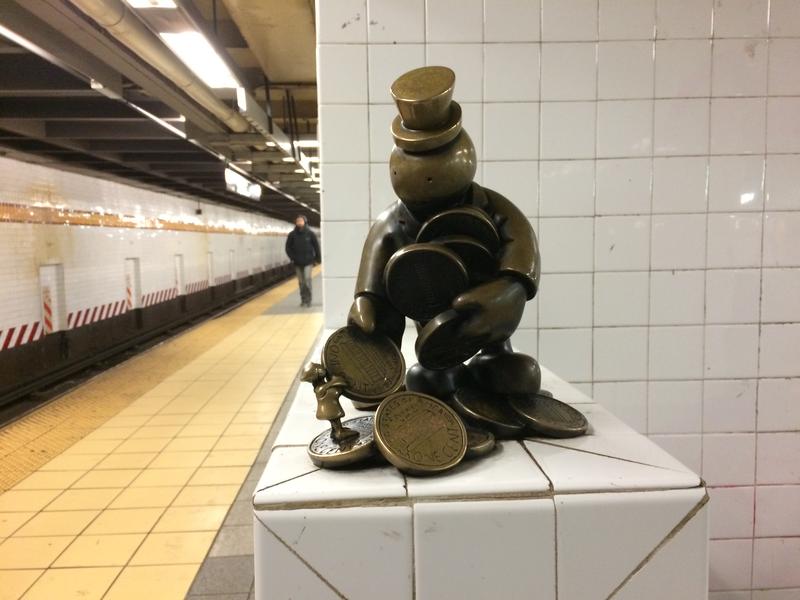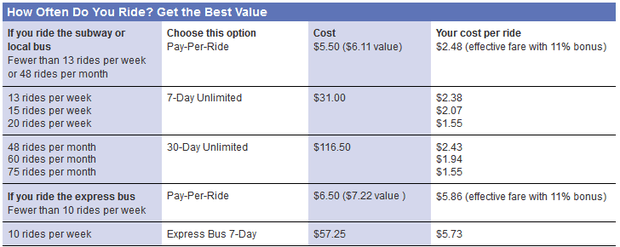 Transportation Nation
Transportation Nation
Everything You Need to Know About the MTA's Fare and Toll Hike

You can't say you didn't know it was coming: the MTA now has biennial fare hikes baked into its operating budgets. And we have talked about this before. But before you head to the transit system on Sunday — or cross the Verrazano Bridge — here's a refresher.
1. So how much will it cost to ride the subway and the bus now?
The base fare is increasing a quarter, to $2.75. But the bonus — the amount the MTA adds on to a MetroCard when multiple rides are purchased — is also going up to 11 percent. So if you front load $5.50 onto a MetroCard, you get a MetroCard worth $6.11. A seven-day unlimited MetroCard will cost $31, and 30-day MetroCards will cost $116.50. Here's the MTA's page about the increase. Remember when the MTA began charging $1 for MetroCards? They're still doing that.
2. But what if I only want to ride the subway once? Is that $2.75?
The cost of a single ride ticket will now be $3, for sale at subway vending machines only. (You can still use cash on the bus.)
3. I ride the subway/bus pretty frequently. Which card should I buy?
Really, only you can answer that question. But the MTA has crunched the numbers and made a chart. If you ride less than 13 times a week, choose the pay-per-ride. If you ride over 48 times per month, pick the monthly. If you ride 13 times a week, choose the weekly. And check your ridership: Gene Russianoff, the head of the Straphangers Campaign, says "25 percent of the people who buy seven or 30-day passes would do better to buy pay-per-ride. In other words, they don't save money by buying the pass."
4. I want to zero out my MetroCard. How much do I have to put on it? That whole 11 percent bonus is taxing my math skills.
There's a website for that: the MTA came out with a MetroCard Calculator. Unfortunately, it's online — which is not that useful when you're, say, standing at a vending machine. But according to it, $23.30 will buy you nine rides, and $50.55 buys you 20.
5. I have to buy a monthly card this weekend. Should I buy it now, or wait until Sunday?
See tweet below!
Buy your $112 MetroCard today or tomorrow; start it using it by or on March 29. That's how to maximize your value before Sunday's fare hike.
— Second Ave. Sagas (@2AvSagas) March 20, 2015
6. I just noticed that my MetroCard is about to expire! Do I have to pay $1 for a new one?
No. You can get swap it for a new one at a vending machine or see a token booth clerk.
7. What about senior fares?
It will be half of the base fare — $1.35.
8. What about Long Island Rail Road and Metro-North fares?
This is a little more complicated, because there are zones involved. The MTA says the "vast majority" of rail commuters will see their fares increase 4.25 percent or less. You can find specific information here.
9. How many times have bus and subway fares gone up on the MTA, anyway?
That's a bit of a trick question, because the MTA itself wasn't created until 1968, so before that, the subways and buses were technically New York City Transit. But here you go:
- 5 cents, 1904 - 1948
- 10 cents, 1948 - 1953
- 15 cents, 1953 - 1966 (also when tokens debuted in the subway)
- 20 cents, 1966 - 1970
- 30 cents, 1970 - 1971
- 35 cents, 1972 - 1975
- 50 cents, 1975 - 1980
- 60 cents, 1980 - 1981
- 75 cents, 1981 - 1984
- 90 cents, 1984 - 1985
- $1, 1986 - 1989
- $1.15, 1990 - 1991
- $1.25, 1992 - 1995
- $1.50, 1995 - 2003 (note: in 1997, the MTA began allowing free transfers between buses and subways)
- $2, 2003 - 2009
- $2.25, 2009 - 2010
- $2.50, 2013 - March 21, 2015
- $2.75, March 22, 2015 -
10. What about tolls?
If MTA tolls had a Facebook status, it would be "it's complicated." Again, the MTA says the increase is roughly 4 percent. But there's a big difference between cash and E-ZPass on most MTA crossings.
If, for example, you want to pay cash to cross the Verrazano Bridge, the toll will be $16. But if you're a Staten Island resident who uses E-ZPass, it's effectively $5.74. If you have E-ZPass but aren't a Staten Islander, the toll is $11.08.
You can find the toll breakdown here.
